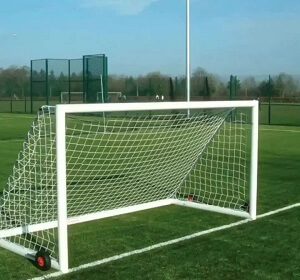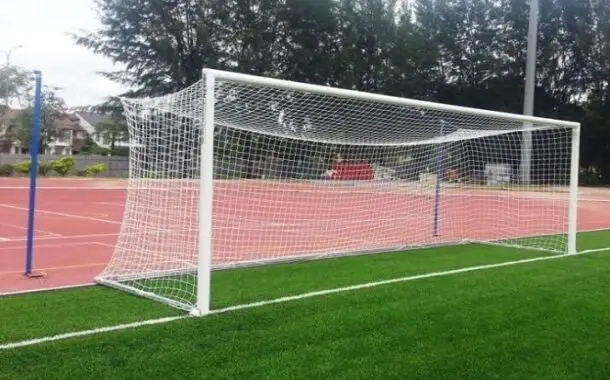Soccer Goals Cost
It is important to know how to choose a soccer goal for the game to take place in excellent conditions. Whether it is an outdoor football field or a specially designed hall, the goal model will be different. Thus, there are mobile or fixed soccer goals that have ground-fixing accessories.
Also, the space where you want to place the field is an important factor depending on which you choose the soccer goal model. The dimensions differ from one model to another, and you have to choose the right length while also taking into account the available space.
How much do soccer goals cost?
The amount of money you are going to spend for a soccer goal will be influenced by the place you buy it from, the materials it is made of, what is being used for, its size, and whether it is portable. You should expect to pay just $20 for a simple inflatable goal and more than $3,200 for a professional soccer goal. In the table below you will find the average costs for different types of soccer goals.
| Type/Brand of Goal | Price Range |
| Walmart Soccer Goal | $35 to $250 |
| SKLZ Soccer Goal | $90 to $355 |
| PUGG Soccer Goal | $25 to $80 |
| Pop Up Soccer Goal | $25 to $85 |
| Mylec Soccer Goal | $35 to $120 |
| Kwik Goal | $1,900 to $3,500 |
| Inflatable Soccer Goal | $8 to $60 |
| Goalrilla Soccer Goal | $200 to $400 |
| Foldable Soccer Goals | $30 to $75 |
| Brava Soccer Goal | $45 to $140 |
| Bownet Soccer | $120 to $400 |
Depending on its features, the price of a small practice goal designed for scrimmage play with no goalie like Infinity Kwik Goal will be anywhere between $60 and $170. In order to avoid falling over, some of these goals are weighted in the back, while others are not. Also, some goals like these have to be put together and taken apart while others have pop-up features.
You might also like our articles on the cost of football helmets, golf balls, or ski equipment.
For a youth-sized goal, you will have to pay anywhere between $620 and $1,700. The bigger it is, the more expensive it gets. Their sizes range from 4’x6’ to 7’x21’.
For instance, you can find a wide variety of soccer goals at the Soccer Garage store. Here you will have to pay anywhere between $110 and $320 for a 6’x12’ soccer goal and $360 to $3,600 for an 8’x24’ soccer goal.
The regular size of a soccer goal is 8’x24’ and depending on the brand, you will have to pay anywhere between $1,100 and $3,200 for it. The most expensive soccer goals are those that include thicker posts for durability, weighted posts for stability, and wheels for easy movement. For instance, the cost of the Evolution Kwik Goal EVO 1.1. is around $2,700.
If you want to improve your abilities at soccer, you will need a training goal like the Coerver Kwik Goal, which is a flat goal that you can use for shooting exercises on two sides. With this, you will gain more experience as it allows more shots per player. Depending on its size, the cost of a training goal will be anywhere between $330 and $780.
In case you want to play soccer when you go out at a picnic and you need a soccer goal that can be easily transported, you should purchase a portable or even inflatable soccer goal. Depending on the brand, this costs anywhere between $40 and $350. For example, a pop-up goal costs anywhere between $30 and $90. This is similar to a portable soccer goal but can be folded up in a bag and you can easily transport it.
There are soccer goals designed for indoor playing as well. Their cost starts at around $135 and can go up to $850 for a best-quality model.
Again, depending on the brand, a mini soccer goal designed for children costs anywhere between $35 and $220.
Soccer goal details
 The soccer goal can be made of various materials such as aluminum, steel, or plastic. Soccer gates usually include mounting accessories on the playing surface and net hooks. However, the net is not included and must be purchased separately.
The soccer goal can be made of various materials such as aluminum, steel, or plastic. Soccer gates usually include mounting accessories on the playing surface and net hooks. However, the net is not included and must be purchased separately.
Also, soccer goals are of different types: fixed or mobile, with a bigger or smaller goal depth, depending on the space held or the place where they are stored.
Once you have purchased the desired soccer goal model, it is time to use the right net depending on the gate. The size of the goal gives you a great hint about the ideal length of the net. The thickness of the wire differs from one model to another and influences its resistance over time. The net must be assembled or disassembled with the help of hooks or clamps provided by the particular goal. The colors can be white or green and the models are provided with different meshes, depending on the user’s preferences.
What are the extra costs?
Over time, the nets for the training soccer goal wear out and need to be replaced. Expect to spend anywhere between $110 and $520 for these nets.
Depending on the durability and quality of the material, and its size as well, the cost of a net for a full-size or youth-size soccer goal will be anywhere between $110 and $430.
In order to attach the net to the frame of the soccer goal, you will need net clips.
In case you will buy a soccer goal that is not weighted, you will have to buy sandbags as well, in order to stabilize the goals.
On the other hand, if the soccer goal is permanent and needs to be installed by a professional, extra fees might be applied.
Top brands to consider
- PUGG
- Champion
- Mitre
- Kwik Goal
- Franklin
How can I save money?
The most important part of a soccer goal is the frame and this should last for many years. So, you can purchase a used soccer goal without the risk of it breaking. There are brands that even sell soccer goals with transferable warranty. You can find a used soccer goal online on websites like Craigslist or eBay.
In case you want a small soccer goal, just for recreational purposes, you can build it yourself using simple PVC piping, which can be bought from Home Depot or other stores like this.


Leave a Reply
Want to join the discussion?Feel free to contribute!